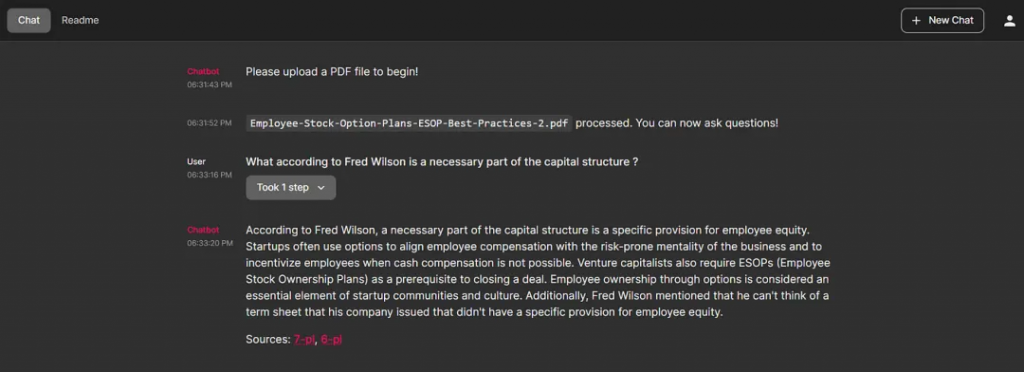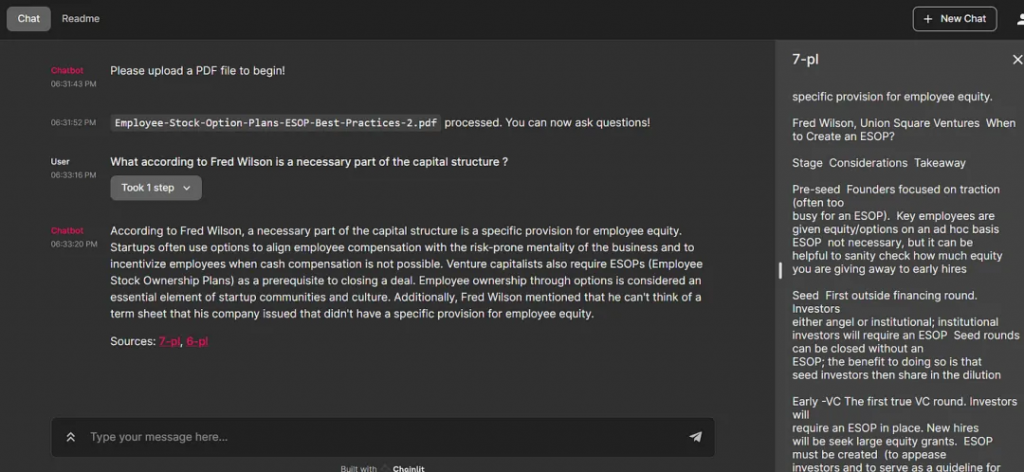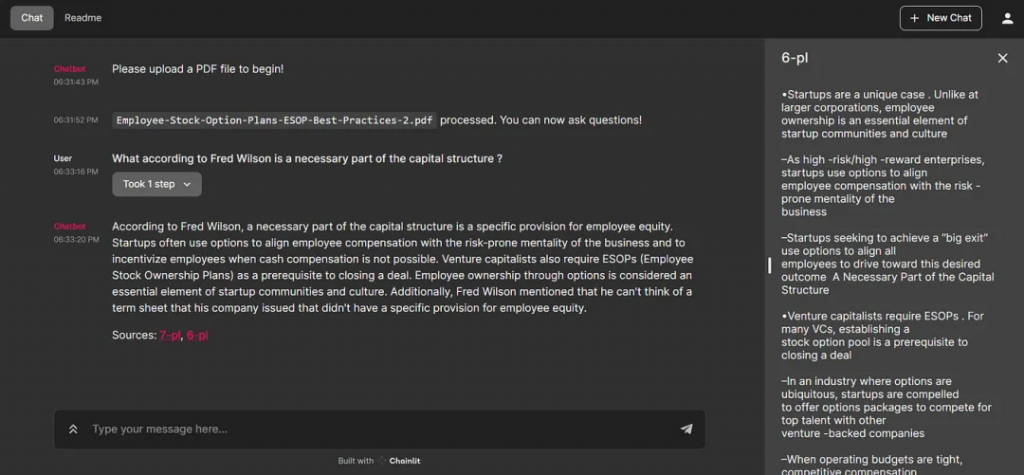LLM漫谈(三)| 使用Chainlit和LangChain构建文档问答的LLM应用程序
一、Chainlit介绍
Chainlit是一个开源Python包,旨在彻底改变构建和共享语言模型(LM)应用程序的方式。Chainlit可以创建用户界面(UI),类似于由OpenAI开发的ChatGPT用户界面,Chainlit可以开发类似streamlit的web界面。
1.1 Chainlit的主要特点
- 可视化中间步骤:Chainlit可以可视化大语言模型管道中的每个步骤;
- Chainlit与Python代码轻松集成,可以快速释放LLM应用程序的潜力;
- 快速响应的UI开发:使用Chainlit可以利用其直观的框架来设计和实现类似于ChatGPT的迷人UI。
1.2 Chainlit装饰器功能
on_message:
与框架的装饰器,用于对来自UI的消息作出反应。每次收到新消息时,都会调用装饰函数。
on_chat_start:
Decorator对用户websocket连接事件作出反应。
1.3 概念
User Session:
user_session是一个存储用户会话数据的字典,id和env键分别保持会话id和环境变量。用户会话其他数据存储在其他key中。
Streaming:
Chainlit支持两种类型的流:
Python Streaming(https://docs.chainlit.io/concepts/streaming/python)
Langchain Streaming(https://docs.chainlit.io/concepts/streaming/langchain)
二、实施步骤
1.开始上传PDF格式文件,确保其正确提交;
2.随后,使用PyPDF2从上传的PDF文档中提取文本内容;
3.利用OpenAIEmbeddings将提取的文本内容转换为矢量化嵌入;
4.将这些矢量化嵌入保存在指定的向量库中,比如Chromadb;
5.当用户查询时,通过应用OpenAIEmbeddings将查询转换为相应的矢量嵌入,将查询的语义结构对齐到矢量化域中;
6.调用查询的矢量化嵌入有效地检索上下文相关的文档和文档上下文的相关元数据;
7.将检索到的相关文档及其附带的元数据传递给LLM,从而生成响应。
三、代码实施
3.1 安装所需的包
pip install -qU langchain openai tiktoken pyPDF2 chainlit
conda install -c conda-forge chromadb3.2 代码实施
#import required libraries
from langchain.embeddings import OpenAIEmbeddings
from langchain.text_splitter import RecursiveCharacterTextSplitter
from langchain.vectorstores import Chroma
from langchain.chains import RetrievalQAWithSourcesChain
from langchain.chat_models import ChatOpenAI
from langchain.prompts.chat import (ChatPromptTemplate,
SystemMessagePromptTemplate,
HumanMessagePromptTemplate)
#
import chainlit as cl
import PyPDF2
from io import BytesIO
from getpass import getpass
#
import os
from configparser import ConfigParser
env_config = ConfigParser()
# Retrieve the openai key from the environmental variables
def read_config(parser: ConfigParser, location: str) -> None:
assert parser.read(location), f"Could not read config {location}"
#
CONFIG_FILE = os.path.join("./env", "env.conf")
read_config(env_config, CONFIG_FILE)
api_key = env_config.get("openai", "api_key").strip()
#
os.environ["OPENAI_API_KEY"] = api_key
# Chunking the text
text_splitter = RecursiveCharacterTextSplitter(chunk_size=1000,chunk_overlap=100)
#
#system template
system_template = """Use the following pieces of context to answer the user's question.
If you don't know the answer, just say that you don't know, don't try to make up an answer.
ALWAYS return a "SOURCES" part in your answer.
The "SOURCES" part should be a reference to the source of the document from which you got your answer.
Begin!
----------------
{summaries}"""
messages = [SystemMessagePromptTemplate.from_template(system_template),HumanMessagePromptTemplate.from_template("{question}"),]
prompt = ChatPromptTemplate.from_messages(messages)
chain_type_kwargs = {"prompt": prompt}
#Decorator to react to the user websocket connection event.
@cl.on_chat_start
async def init():
files = None
# Wait for the user to upload a PDF file
while files is None:
files = await cl.AskFileMessage(
content="Please upload a PDF file to begin!",
accept=["application/pdf"],
).send()
file = files[0]
msg = cl.Message(content=f"Processing {file.name}...")
await msg.send()
# Read the PDF file
pdf_stream = BytesIO(file.content)
pdf = PyPDF2.PdfReader(pdf_stream)
pdf_text = ""
for page in pdf.pages:
pdf_text += page.extract_text()
# Split the text into chunks
texts = text_splitter.split_text(pdf_text)
# Create metadata for each chunk
metadatas = [{"source": f"{i}-pl"} for i in range(len(texts))]
# Create a Chroma vector store
embeddings = OpenAIEmbeddings(openai_api_key=os.getenv("OPENAI_API_KEY"))
docsearch = await cl.make_async(Chroma.from_texts)(
texts, embeddings, metadatas=metadatas
)
# Create a chain that uses the Chroma vector store
chain = RetrievalQAWithSourcesChain.from_chain_type(
ChatOpenAI(temperature=0,
openai_api_key=os.environ["OPENAI_API_KEY"]),
chain_type="stuff",
retriever=docsearch.as_retriever(),
)
# Save the metadata and texts in the user session
cl.user_session.set("metadatas", metadatas)
cl.user_session.set("texts", texts)
# Let the user know that the system is ready
msg.content = f"{file.name} processed. You can now ask questions!"
await msg.update()
cl.user_session.set("chain", chain)
# react to messages coming from the UI
@cl.on_message
async def process_response(res):
chain = cl.user_session.get("chain") # type: RetrievalQAWithSourcesChain
cb = cl.AsyncLangchainCallbackHandler(
stream_final_answer=True, answer_prefix_tokens=["FINAL", "ANSWER"])
cb.answer_reached = True
res = await chain.acall(res, callbacks=[cb])
print(f"response: {res}")
answer = res["answer"]
sources = res["sources"].strip()
source_elements = []
# Get the metadata and texts from the user session
metadatas = cl.user_session.get("metadatas")
all_sources = [m["source"] for m in metadatas]
texts = cl.user_session.get("texts")
if sources:
found_sources = []
# Add the sources to the message
for source in sources.split(","):
source_name = source.strip().replace(".", "")
# Get the index of the source
try:
index = all_sources.index(source_name)
except ValueError:
continue
text = texts[index]
found_sources.append(source_name)
# Create the text element referenced in the message
source_elements.append(cl.Text(content=text, name=source_name))
if found_sources:
answer += f"\nSources: {', '.join(found_sources)}"
else:
answer += "\nNo sources found"
if cb.has_streamed_final_answer:
cb.final_stream.elements = source_elements
await cb.final_stream.update()
else:
await cl.Message(content=answer, elements=source_elements).send()3.3 运行应用程序
chainlit run <name of the python script>3.4 Chainlit UI



点击返回的页码,详细说明所引用的文档内容。


我们也可以更改设置。

参考文献:
[1] https://medium.aiplanet.com/building-llm-application-for-document-question-answering-using-chainlit-d15d10469069
文章转自微信公众号@ArronAI
最新文章
- 小红书AI文章风格转换:违禁词替换与内容优化技巧指南
- REST API 设计:过滤、排序和分页
- 认证与授权API对比:OAuth vs JWT
- 如何获取 Coze开放平台 API 密钥(分步指南)
- 首次构建 API 时的 10 个错误状态代码以及如何修复它们
- 当中医遇上AI:贝业斯如何革新中医诊断
- 如何使用OAuth作用域为您的API添加细粒度权限
- LLM API:2025年的应用场景、工具与最佳实践 – Orq.ai
- API密钥——什么是API Key 密钥?
- 华为 UCM 推理技术加持:2025 工业设备秒级监控高并发 API 零门槛实战
- 使用JSON注入攻击API
- 思维链提示工程实战:如何通过API构建复杂推理的AI提示词系统